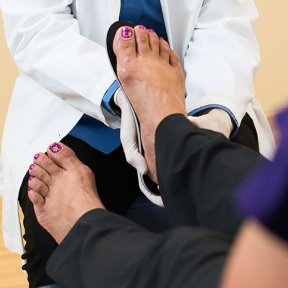Hours:
Monday - Friday
8:00 a.m. - 5:00 p.m.
Schedule a podiatry appointment
Podiatric Medicine
Podiatric medicine strives to improve the health and well-being of patients by focusing on preventing, diagnosing, and treating conditions associated with the foot, ankle, and lower extremities. Podiatric physicians treat patients of all ages from new born to the elderly. Podiatrists are often the first to recognize and diagnose diseases such as diabetes, high blood pressure, and heart disease as well as their associated complications.
The Foot and Ankle Services team provides compassionate foot, ankle, and leg care including heel pain, injuries, foot problems in children, reconstructive surgery, sports medicine, wound care, complications from diabetes, skin and nail disorders, gait abnormalities, and much more. Each of the podiatric physicians at the Clinic is a member of the teaching faculty of the Arizona College of Podiatric Medicine at the Glendale Campus of Midwestern University. They are either Board Certified or Board Qualified in Podiatric Surgery. In addition to state of the art patient care, our podiatrists are engaged in cutting edge research to advance the understanding and care of lower extremity problems.
For more information about Foot and Ankle problems visit the following pages:
Our Areas of Practice
Diabetes Related Concerns
Critical members of the healthcare team for the diabetic patient, podiatric physicians will assess foot risk, help the patient with prevention of complications, and manage the problems that may arise such as a loss of sensation or burning pain, muscle weakness and the need for bracing, skin breakdown and wound healing challenges, foot infection and gangrene, and specialty shoe gear. Regular visits to the podiatrist are important your foot health.
Foot and Ankle Trauma
Foot and Ankle trauma including fractures (broken bones), foreign bodies, puncture wounds, ligament injuries (sprains) and tendon ruptures. Our Podiatrists will take the necessary X-rays on-site in the office to help establish the correct diagnosis and offer appropriate treatment recommendations. While many injuries can be treated non-operatively with immobilization and therapy, some injuries do require surgical intervention.
Gait Abnormalities
Gait abnormalities reveal a lot about possible underlying pathology. Leg length differences, a limp, a dropfoot, intoed or out-toed gait, excessive pronation or a lack of normal motion are all indications of disorders that should be investigated further. Your podiatrist will thoroughly assess gait as needed.
Heel Pain
Heel pain is the most frequent complaint encountered in the practice of a podiatric physician. The most common cause of heel pain is plantar fasciitis, inflammation in the thick ligamentous band on the bottom of the foot. But heel pain can arise from many other causes and should be thoroughly assessed if it persists more than a few weeks. Stress fractures, bone tumors, infections, bursitis, tendonitis, and bone spurs are among the many potential causes of heel pain.
Pediatrics
Pediatric foot problems range from the minor, such as warts and athlete’s foot, to the significant, such as congenital deformities. Your podiatric physician can diagnose and treat any foot problem in youngsters including flat feet, club feet, tight Achilles tendons, and so on.
Reconstructive Surgery
Podiatric Surgeons perform reconstructive surgery when non-operative treatment options have failed to help the problem or if notable deformity is the underlying cause of the problem. Reconstructive surgery is non-emergent. Some examples include ankle instability, tendon pathology, treating arthritic joints, realigning deformity such as Cavus foot (high arches) or Planus foot (flatfoot), digital deformity (toes), removal of tumors/masses, treatment of neuromas or nerve entrapments, and ankle arthroscopy.
Skin and Nail Problems
Common skin and nail problems such as ingrown toenails, fungal nails, athletes foot, painful corns and calluses, warts, heel fissures and rashes can be treated by our Podiatric Physicians. Pigmented lesions (moles) can be benign or dangerous just like atypical skin lesions on the back or face and may warrant a biopsy.
Sports Medicine
Podiatric foot and ankle specialists are invaluable to the athlete, whether weekend warrior or professional. Guidance about shoe selection, prescription Orthotics, training patterns, and so forth is combined with the management of acute injury such as Turf Toe and overuse injuries such as posterior tibial tendonitis.
Products
For the convenience of our patients, we stock a variety of topical medications, foot and ankle supports, toe and foot pads/protectors/sleeves, immobilization devices, OTC insole supports and custom orthotics.
Dedicated to Service
What to Expect
Take a closer look to understand what to expect when you visit the Multispecialty Clinic and our Foot and Ankle services.
Meet Our Care Providers
University faculty work closely with our students to provide your healthcare.



